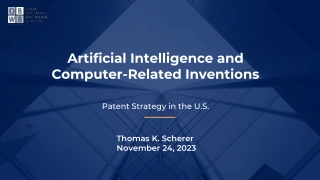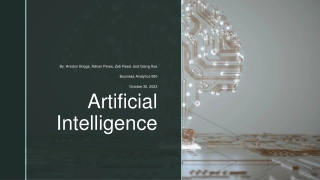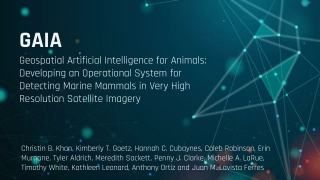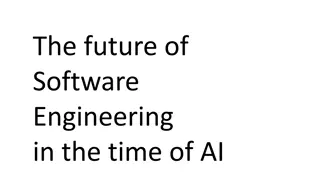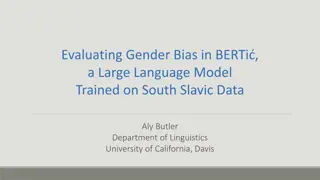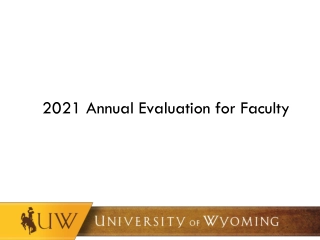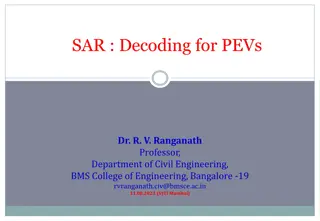Understanding Model Evaluation in Artificial Intelligence
Exploring the evaluation stage in AI model development, how to assess model reliability, avoid overfitting and underfitting, and understand key terminologies like True Positive, True Negative, and False Positive in a forest fire prediction scenario.
Download Presentation
Please find below an Image/Link to download the presentation.
The content on the website is provided AS IS for your information and personal use only. It may not be sold, licensed, or shared on other websites without obtaining consent from the author. Download presentation by click this link. If you encounter any issues during the download, it is possible that the publisher has removed the file from their server.
Presentation Transcript
ARTIFICIAL INTELLIGENCE
EVALUATION EVALUATION Introduction Introduction In the Evaluation stage, we will explore different methods of evaluating an AI model. Model Evaluation is an integral part of the model development process. It helps to find the best model that represents our data and how well the chosen model will work in the future What What is is evaluation? evaluation? Evaluation is the process of understanding the reliability of any AI model, based on outputs by feeding test dataset into the model and comparing with actual answers. There can be different Evaluation techniques, depending of the type and purpose of the model. Remember that It s not recommended to use the data we used to build the model to evaluate it. This is because our model will simply remember the whole training set, and will therefore always predict the correct label for any point in the training set. This is known as Overfitting. When the model neither learns from the training dataset nor generalizes well on the test dataset,it is termed as Underfitting. Perfectfit is when the model picks up the patterns from the training data and does not end up memorizing the finer details. This,in turn would ensure that the model generalizes and accurately predicts other data samples.
Model Evaluation Terminologies The The Scenario Scenario Imagine that you have come up with an AI based prediction model which has been deployed in a forest which is prone to forest fires. Now, the objective of the model is to predict whether a forest fire has broken out in the forest or not. Now, to understand the efficiency of this model, we need to check if the predictions which it makes are correct or not. Thus, there exist two conditions which we need to ponder upon: Prediction and Reality. The prediction is the output which is given by the machine and the reality is the real scenario in the forest when the prediction has been made. Now let us look at various combinations that we can have with these two conditions. 03 04
Case Case 1: 1: Is Is there there a a forest fire? forest fire? Here, we can see in the picture that a forest fire has broken out in the forest. The model predicts a Yes which means there is a forest fire. The Prediction matches with the Reality. Hence, this condition is termed as True Positive.
Case Case 2: 2: Is Is there there a a forest fire? forest fire? Here there is no fire in the forest hence the reality is No. In this case, the machine too has predicted it correctly as a No. Therefore, this condition is termed as True Negative.
Case Case 3: 3: Is Is there there a a forest fire? forest fire? Here the reality is that there is no forest fire. But the machine has incorrectly predicted that there is a forest fire. This case is termed as False Positive.
Case Case 4: 4: Is Is there there a a forest fire? forest fire? Here, a forest fire has broken out in the forest because of which the Reality is Yes but the machine has incorrectly predicted it as a No which means the machine predicts that there is no Forest Fire. Therefore, this case becomes False Negative.
Confusion Confusion matrix The result of comparison between the prediction and reality can be recorded in what we call the confusion matrix. The confusion matrix allows us to understand the prediction results. matrix
Let us now take a look at the confusion matrix: Prediction and Reality can be easily mapped together with the help of this confusion matrix.
Evaluation Evaluation Methods Methods Accuracy Accuracy is defined as the percentage of correct predictions out of all the observations. A prediction can be said to be correct if it matches the reality. Here, we have two conditions in which the Prediction matches with the Reality: True Positive and True Negative. Hence, the formula for Accuracy becomes: Here, total observations cover all the possible cases of prediction that can be True Positive (TP), True Negative (TN), False Positive (FP) and False Negative (FN).
FOREST SCENARIO: Assume that the model always predicts that there is no fire. But in reality, there is a 2% chance of forest fire breaking out. In this case, for 98 cases, the model will be right but for those 2 cases in which there was a forest fire, then too the model predicted no fire. Here, True Positives = 0 True Negatives = 98 Total cases = 100 Therefore, accuracy becomes: (98 + 0) / 100 = 98%
This is a fairly high accuracy for an AI model. But this parameter is useless for us as the actual cases where the fire broke out are not taken into account. Hence, there is a need to look at another parameter which takes account of such cases as well.
Precision Precision is defined as the percentage of true positive cases versus all the cases where the prediction is true. That is, it takes into account the True Positives and False Positives. FOREST SCENARIO: Assume that the model always predicts that there is a forest fire irrespective of the reality. In this case, all the Positive conditions would be taken into account that is, True Positive (Prediction = Yes and Reality = Yes) and False Positive (Prediction = Yes and Reality = No). In this case, the firefighters will check for the fire all the time to see if the alarm was True or False.
Let us consider that a model has 100% precision. Which means that whenever the machine says theres a fire, there is actually a fire (True Positive). In the same model, there can be a rare exceptional case where there was actual fire but the system could not detect it. This is the case of a False Negative condition. But the precision value would not be affected by it because it does not take FN into account. Is precision then a good parameter for model performance?
Recall Another parameter for evaluating the model s performance is Recall. It can be defined as the fraction of positive cases that are correctly identified. It majorly takes into account the true reality cases where in Reality there was a fire but the machine either detected it correctly or it didn t. That is, it considers True Positives (There was a forest fire in reality and the model predicted a forest fire) and False Negatives (There was a forest fire and the model didn t predict it). Now as we notice, we can see that the Numerator in both Precision and Recall is the same: True Positives. But in the denominator, Precision counts the False Positives while Recall takes False Negatives into consideration.
Which Which Metric Choosing between Precision and Recall depends on the condition in which the model has been deployed. In a case like Forest Fire, a False Negative can cost us a lot and is risky too. Imagine no alert being given even when there is a Forest Fire. The whole forest might burn down. Metric is is Important? Important? Another case where a False Negative can be dangerous is Viral Outbreak. Imagine a deadly virus has started spreading and the model which is supposed to predict a viral outbreak does not detect it. The virus might spread widely and infect a lot of people. On the other hand, there can be cases in which the False Positive condition costs us more than False Negatives. One such case is Mining. Imagine a model telling you that there exists treasure at a point and you keep on digging there but it turns out that it is a false alarm. Here, False Positive case (predicting there is treasure but there is no treasure) can be very costly. Similarly, let s consider a model that predicts that a mail is spam or not. If the model always predicts that the mail is spam, people would not look at it and eventually might lose important information. Here also False Positive condition (Predicting the mail as spam while the mail is not spam) would have a high cost.
To conclude the argument, we must say that if we want to know if our models performance is good, we need these two measures: Recall and Precision. For some cases, you might have a High Precision but Low Recall or Low Precision but High Recall. But since both the measures are important, there is a need of a parameter which takes both Precision and Recall into account.
F1 Score F1 score can be defined as the measure of balance between precision and recall. Take a look at the formula and think of when can we get a perfect F1 score? An ideal situation would be when we have a value of 1 (that is 100%) for both Precision and Recall. In that case, the F1 score would also be an ideal 1 (100%). It is known as the perfect value for F1 Score. As the values of both Precision and Recall ranges from 0 to 1, the F1 score also ranges from 0 to 1.
Let us explore the variations we can have in the F1 Score: Precision Recall F1 Score Low Low Low High Low Low Low High Low High High High In conclusion, we can say that a model has good performance if the F1 Score for that model is high.
ASSIGNMENT FOR PRACTICE: 1. Rajat has made a model which predicts the performance of Indian Cricket players in upcoming matches. He collected the data of players performance with respect to stadium, bowlers, opponent team and health. His model works with good accuracy and precision value. Which of the statement given below is incorrect? a) Data gathered with respect to stadium, bowlers, opponent team and health is known as Testing Data. b) Data given to an AI model to check accuracy and precision is Testing Data. c) Training data and testing data are acquired in the Data Acquisition stage. d) Training data is always larger as compared to testing data. 2. Statment1: The output given by the AI model is known as reality. Statement2:The real scenario is known as Prediction. (a)Both Statement1 and Statement2 are correct (b)Both Statement1 and Statement2 are incorrect (c) Statement1 is correct but Statement2 is incorrect (d) Statement2 is correct but Statement1 is incorrect 3. F1 Score is the measure of the balance between (a) Accuracy and Precision (b) Precision and Recall (c) Recall and Accuracy (d) Recall and Reality
4. Sarthak made a face mask detector system for which he had collected the dataset and used all the dataset to train the model. Then, he used the same data to evaluate the model which resulted in the correct answer all the time but was not able to perform with unknown dataset. Name the concept. 5. Which evaluation parameter takes into consideration all the correct predictions? 6. Which one of the following scenario result in a high false positive cost? (a)viral outbreak (b)forest fire (c)flood (d)spam filter 7. Draw the confusion matrix for the following data the number of true positive = 100 the number of true negative 47 the number of false positive = 62 the number of false negative = 290
8. An AI model made the following sales prediction for a new mobile phone which they have recently launched: (i) Identify the total number of wrong predictions made by the model. (ii) Calculate precision, recall and F1 Score.
Find out Accuracy, Precision, Recall and F1 Score for the given problems. Scenario 1: In schools, a lot of times it happens that there is no water to drink. At a few places, cases of water shortage in schools are very common and prominent. Hence, an AI model is designed to predict if there is going to be a water shortage in the school in the near future or not. The confusion matrix for the same is:
Scenario 2: Nowadays, the problem of floods has worsened in some parts of the country. Not only does it damage the whole place but it also forces people to move out of their homes and relocate. To address this issue, an AI model has been created which can predict if there is a chance of floods or not. The confusion matrix for the same is:
Scenario 3: A lot of times people face the problem of sudden downpour. People wash clothes and put them out to dry but due to unexpected rain, their work gets wasted. Thus, an AI model has been created which predicts if there will be rain or not. The confusion matrix for the same is:
Scenario 4: Traffic Jams have become a common part of our lives nowadays. Living in an urban area means you have to face traffic each and every time you get out on the road. Mostly, school students opt for buses to go to school. Many times the bus gets late due to such jams and students are not able to reach their school on time. Thus, an AI model is created to predict explicitly if there would be a traffic jam on their way to school or not. The confusion matrix for the same is:





